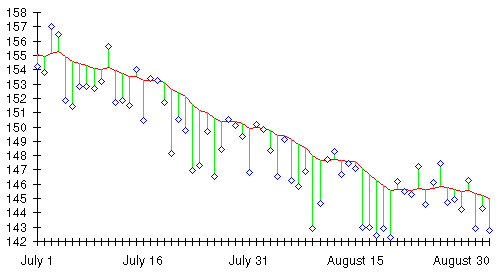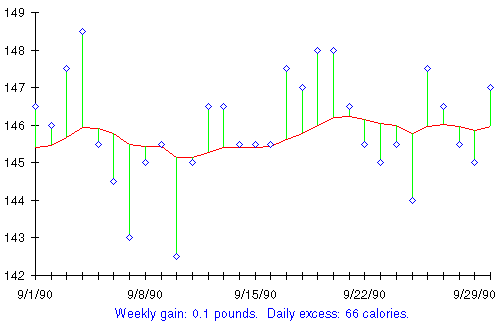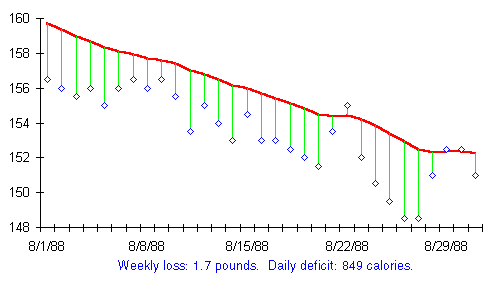
Next, consider the trend line along with the daily weights from the scale.

The trend line is drawn in as before, and each day's weight is plotted as a diamond. I've drawn lines from each weight measurement to the trend line to show the relationship between daily weight and the trend that day. Remember, in an exponentially smoothed moving average the most recent day's measurement has the greatest influence on the trend line. Recall also, that since the moving average looks back in time, it lags the actual trend. Consequently, when the trend is falling, most of the daily weights will be below the moving average trend line. Think of the trend as a fishing line in the water. Daily weights that fall below it are sinkers, pulling it down; the further the weight is below the trend line, the stronger it pulls the trend line down. When the trend is rising, most daily weights will be above the trend line: floats, tethered to the line, pulling it up.
The relationship between the trend line and the daily weights is another powerful indicator of what's really going on. It provides important information to Dexter during the course of his diet. No tabulation is required; a simple glance at the chart shows that regardless of all the ups and downs in daily weight, discounting a very few exceptions, the trend line, the indicator of Dexter's true weight, was being pulled down continuously. The apparent weight plateau that frustrated Dexter in the days preceding July 10th is seen in a very different light now. Even though his weight on the scale stubbornly refused to budge for about a week, every weight that week fell below the trend line and, consequently, dragged it downward.
The few days on which the rubber bag was brimming with water or what NASA refers to delicately as ``solids,'' those days that occasioned Dexter such despair when viewed in isolation, are also seen in much better perspective on this chart. Many of these days, in fact the great majority, are actually below the trend line and still, regardless of their relationship to earlier days, act to pull it down. Those that manage to pop above the trend line have an impact on it which is clearly insignificant.
The relationship between the daily weight readings and the trend line is not only a powerful psychological tool in controlling weight, it also provides early warning about shifts in calorie intake and therefore changes in the trend of weight. While you're losing weight, you'll see a chart that looks like Dexter's: a falling trend line with most daily weights below it. Once you've stabilised your weight and are holding it essentially constant, you'll see a chart that looks like this, instead.

I don't have to make up a name for this individual; this is my own chart for September 1990. My true weight that month held essentially steady right where I want it, around 145 pounds. As measured by the trend line, my weight that month never exceeded 146 1/4 nor fell below 145 1/4. Yet, like Dexter, if I'd relied solely on the scale to track my progress, I'd have seen a very different picture. While my true weight didn't vary by more than a pound that month, the difference between the highest and lowest daily weights on the scale was six pounds--from a high of 149.5 to a low of 142.5. This chart shows the reality of stable weight, with the slightest discernable upward bias. The upward trend has been calculated to be equivalent to an excess of 66 calories a day, comparable to a single Oreo cookie, half a tablespoon of mayonnaise, or 5 peanuts roasted in the shell (each 50 calories), or half a can (6 oz.) of Pepsi (79 calories).
When the trend shifts from weight loss to gain, whether by intention (as in the following chart) or accidentally, the direction of the trend line and the relationship of the daily weights to it quickly diagnose the situation. Here's another of my own weight charts, this one from March of 1990. That month I'd slipped a little below my target of 145, so I decided to indulge in a few extra treats to bring my weight back up to the goal.

Note the dramatic change around March 8th, as I pushed the feeding throttle up a notch. The weight readings, which had previously been mostly below the trend line, pulling it down, shifted predominantly above it, dragging it back upward. The prior downtrend was arrested and gave way to a comparable mild uptrend amounting, over the month, to a rate equal to a third of a pound per week. This was accomplished eating about an extra 170 calories a day, an adjustment I made by enjoying either a bowl of popcorn or a couple of slices of cheese in the evening.
If I hadn't been deliberately bringing my weight up to the target but had, instead, inadvertently thrown my weight out of balance by munching the odd handful of pistachio nuts (1 oz. = 170 calories) in the afternoon, this chart would quickly make me aware of the trouble I was getting myself into. A gain of a third of a pound per week is a comfortable, easy way to drift upward when you'd like to add a few pounds but, if it goes unnoticed and unchecked, will leave you 17 pounds heavier in a year. The trend chart, if heeded, will keep such slow and subtle weight creep from blindsiding you. Whenever you see a chart like this one and you aren't deliberately putting on weight, just cut back a few calories a day to restore the balance before a real problem develops.
To complete the picture, here's my weight chart for August 1988--toward the end of the diet that took me from 215 pounds in January 1988 to my target of 145 in November that same year.

This chart is typical of a serious diet in mid-course: the trend line
is more consistent than Dexter's chart on page ![]() since my diet was underway months before the first day on the chart.
As you'd expect, virtually every daily weight fell below the already
falling trend line and acted to pull it down. Although the daily
weight jumped all over the place, the trend line was almost
ruler-straight for the month, indicating weight loss at the rate of
1.7 pounds a week, or 850 fewer calories going in my rubber bag every
day than I burned. (Unlike the stability or slow upward drift in the
previous charts, a daily shortfall of 850 calories is serious
business. When you constrict the intake of the rubber bag to that
extent, the sentient being inside is going to say, ``What happened?,''
probably accompanied by colourful language and epithets too powerful
for this fragile and flammable paper to contain. An 850 calorie per
day deficit corresponds to a loss of 90 pounds a year, plenty to deal
with all but the most extreme weight problems in relatively short
order. Notwithstanding the realities of such a severe weight-loss
regime, which I'll discuss in chapter
since my diet was underway months before the first day on the chart.
As you'd expect, virtually every daily weight fell below the already
falling trend line and acted to pull it down. Although the daily
weight jumped all over the place, the trend line was almost
ruler-straight for the month, indicating weight loss at the rate of
1.7 pounds a week, or 850 fewer calories going in my rubber bag every
day than I burned. (Unlike the stability or slow upward drift in the
previous charts, a daily shortfall of 850 calories is serious
business. When you constrict the intake of the rubber bag to that
extent, the sentient being inside is going to say, ``What happened?,''
probably accompanied by colourful language and epithets too powerful
for this fragile and flammable paper to contain. An 850 calorie per
day deficit corresponds to a loss of 90 pounds a year, plenty to deal
with all but the most extreme weight problems in relatively short
order. Notwithstanding the realities of such a severe weight-loss
regime, which I'll discuss in chapter ![]() , it
hardly implies incapacitation. That very month, August 1988, I
researched, wrote, and presented the proposal that launched the
Autodesk Cyberspace Initiative, our effort to make ``virtual reality''
technology available to everybody--to allow computer users to cross
the barrier of the screen and directly experience the world inside
their computers.)
, it
hardly implies incapacitation. That very month, August 1988, I
researched, wrote, and presented the proposal that launched the
Autodesk Cyberspace Initiative, our effort to make ``virtual reality''
technology available to everybody--to allow computer users to cross
the barrier of the screen and directly experience the world inside
their computers.)
By John Walker